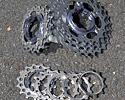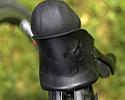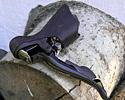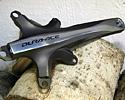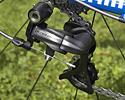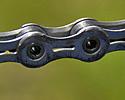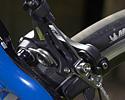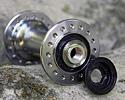
Recently on Cyclingnews.com |
Tech feature: Dura-Ace 7900 first ride, July 17, 2008
On the road (finally!) with Dura-Ace 7900
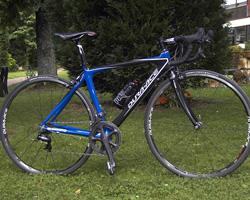
|
Shimano's new Dura-Ace 7900 group has been billed as 'the next big thing' but can it live up to its promise? Cyclingnews technical editor James Huang departs the Tour de France for the official launch in the lush green hills of Ebnisee, Germany to gather some first impressions (and some impromptu interval training).
All in the palm of our hands
Of all the updates unveiled for Dura-Ace 7900, we've held the highest hopes for the changes to the new STI Dual Control levers. Now that we've logged some actual saddle time, we can confirm that the revised shape is everything it's cracked up to be, at least in terms of ergonomics.
The body's markedly increased girth overall and flatter top yield a far more comfortable perch than 7800's overly concave shape and the knob at the top of the lever still offers a good place to set your palms when you're trying to go aero even without the benefit of the old version's exposed cable housing to hook your thumbs around.
The carbon lever blade's outward cant is a more natural fit, too, and the long-awaited reach adjustment proved rather handy on the PRO anatomic-bend bar we used during this initial testing. Even before bringing the levers closer to the bar, though, the new shifter's larger paddles down below offers bigger targets that are easier to find when you're in the drops and going hard.
Rear shifts actually feel identical to 7800 with the usual incredibly light and smooth action we've become accustomed to from Shimano. Considering the concealed derailleur housing's slightly more convoluted gear cable routing, this should be probably be viewed as an improvement.
Even so, we had hoped for a little more here. Shimano claims a 20 percent shorter throw for the main right-hand lever but if that's the case, it's hardly noticeable. As compared to Campagnolo and SRAM's newest Red group, Dura-Ace 7900's lever throws seem far longer, especially for upshifts. The XTR group's more advanced Instant Release and Multi-Release functions have been skipped over here in the name of weight saving, too, which means you can still only upshift one gear at a time (Red obviously has the same limitation but its far shorter throw still makes for faster multiple upshifts). In a distinct step backwards, you can now only downshift two gears at a time, not three as with 7800.
Front shift performance is simply stunning, however, and is without doubt one of the highlights of Dura-Ace 7900. The lever action is lighter and crisper thanks to the revised cable pull ratio, and the new hollow outer chainring's stiffer construction and updated ramp profiling yield very real dividends in terms of shift quality, particularly when you're hard on the gas. As promised, we never experienced any chain rub in the big-big combination thanks to the slighter wider front derailleur cage and didn't miss that outer trim position one bit.
The new chain seems to help here, too, with its differentially-profiled side plates. The inner and outer sides are now completely distinct (mechanics: take care during installation) and Shimano says the shaping improves shift quality by optimizing the interaction with the unique front and rear chain pick-up points. Again, we didn't notice it much out back (although seriously, how much smoother could it be?) but this seems to hold true up front.
Interestingly, Shimano claims the new chain will not only shift better but will maintain that level of performance longer as the drivetrain components wear. We couldn't quite understand how exactly it achieved this feat but will put it to the test regardless once we receive our long-term evaluation group.
We also didn't get a chance to play with the new SM-CN79 Quicklink in person but the tool-free master link will definitely be backwards-compatible with all existing 10-speed Shimano chains. Hallelujah.
Improvements in drivetrain smoothness and longevity
The 7900 crankset will surely stand as testament to the power of aluminum engineering as it's supposedly about 20 percent stiffer than the old 7800 benchmark yet a modest 15g lighter. The spider is far more deeper to match up with the new hollow outer chainring and of course, the arms are still hollow-forged. We were surprised again to find the pinch bolt-style attachment for the non-driveside arm but Shimano claims the XTR-style interference fit would have widened the pedal stance width too much (although curiously, it uses it on the carbon Dura-Ace FC-7800C crank).
Speaking of that carbon crank, the new 7900 unit now matches it in terms of stiffness yet we expect it to be far less expensive plus it's only 10g heavier. If the case for the carbon crank was weak before, we're even less sure who would go with it now save for the distinctly well-heeled who want some sort of outward symbol of their financial status. Even so, Shimano has given the 7800C a new outer chainring for 2009. Go figure.
Not much has changed to the rear cassette although more aggressive machining and the addition of a fourth titanium cog (last year there were only three) mean slightly lighter weight. As mentioned in an earlier report, there's a broadly expanded size range which means more usable gearing for more casual cyclists.
Our drivetrain was fantastically smooth-running and eerily quiet during our brief test period. Granted, most are when they're new but this Dura-Ace 7900 setup seemed even more so than usual, making us wonder if we might gain the same effect by swapping in this new chain on other drivetrain makes.
Whoa, Nelly!
The new brakes are another standout performer on 7900. Shimano only claims a modest 8 percent improvement in dry braking power (and 100 percent in wet) but the increased control and modulation afforded by the stiffer caliper arms make it feel like much more on the road (as we inadvertently discovered heading into a tight downhill hairpin while going way too fast).
Lever action is markedly improved thanks to the revised cable pull geometry while the new pivot location (it's now slightly closer to the bar) feels more natural in your hands and is easier to grab while on the hoods. Moving the shift mechanism further back into the lever body and disconnecting it from the brake lever also yields a lighter and snappier feel as there's less mass to move around.
Not to be overlooked are the revised barrel adjusters which sit noticeably lower than before. While this doesn't sound all that significant on paper, it provides very real improvements in cable routing, especially on more aggressively sloped frames or shorter/lower stems.
An end to cone wrenches
Shimano's previous press release stated that adjusting the new hubs' angular contact bearings would require only one 5mm hex wrench. One size perhaps, but you still need two of them to remove the axle end cap and get the process started. Lying beneath is a clever lockring that is keyed on the outside to keep it from rotating relative to the axle and indexed on the inside to match up with the new adjusting cone.
To make the adjustment, you simply advance or retard the adjusting cone by hand until you achieve the desired level of smoothness, pop the lockring back on top and screw the axle end cap back on to tie everything together. The new aluminum axle is more rigid axially, too, so the adjustment won't be affected by skewer tightness as much as before, either. [Did we lose you back there somewhere? Don't worry; the process is far easier to do than explain.]
Seasoned mechanics might find the new procedure slower and a bit more cumbersome than before (and far more so as compared to Campagnolo's system) but novice mechanics will certainly find the new adjustment method to be far more straightforward. And to be fair, most riders will only have to do this once or twice.
FlightDeck comes of age
Shimano's integrated FlightDeck computer has always struck us as an intriguing concept but also one that fell short in execution for one reason or another. Although we didn't get to try the new version in Germany, we learned enough new information about it to really pique our interest this time around.
The new setup will be truly wireless with coded 2.4GHz transmission, unlike the current 'wireless' model that still has cables running from the shifter bodies to the computer head. Installation will be hugely improved as well, and not just because you no longer have to pull back the handlebar tape. FlightDeck users will now simply have to pull back the front of the shifter hood on either side, remove the top 'knob' of the shifter, then install the FlightDeck module in its place. Slap on the front wheel sensor, magnet and computer head and off you go. This also means that the buttons also get moved from the inner sides to the shifter peak.
There will also be some long-awaited functions added, such as an integrated heart rate monitor, altimeter and calorie estimator. Users will be able to download ride data on to a PC for later review and analysis but Mac users will be left out in the cold for the time being as it'll only be Windows-compatible at first. A standard USB interface will make for easy updates and upgrades later on.
And just what sort of updates and upgrades might we be speaking of, you ask? Much to our surprise, Shimano readily admitted that it had a power meter and GPS system currently in development. We're not sure how it would integrate GPS functionality into the presumably small-sized screen but no matter; the thought of a Shimano-engineered power meter has got our minds racing and we can't wait to see what becomes of this. Stay tuned.
Concerns and compatibility
Other than what we already mentioned, a few other details gave us pause during our brief interlude with this new Dura-Ace 7900 group and nearly all of them have to do with the STI Dual Control levers. 7800's internals were reasonably well-protected from the elements but 7900's are noticeably exposed with no protective covers whatsoever in key areas. You can even easily see the main ratchet wheel from below so we can't help but wonder how these will hold up come 'cross season or in nastier climates. One good digger into the mud will likely be all it takes to jam these up right quick.
We love the adjustable lever reach but to do so requires loosening a tiny screw and then removing a small cover plate at the top of the lever blade to access the small adjustment pin (which is made of plastic). This plate also has to be removed in order to replace the brake cable. To be fair, it isn't necessary to completely remove the cover plate screw but we'd bet that most mechanics won't remember that. That screw is entirely too easy to lose and finding a suitable replacement will require more than heading to the local hardware store.
Fit and finish on the new levers is a bit disappointing as well but not how you'd think. No, the carbon levers and the entire group's distinct two-tone aesthetic is flawlessly executed to a level unmatched by its rivals but yet the STI lever hoods fit inexplicably poorly (it's somewhat lumpy) and shortening the brake lever reach leaves an unsightly gap up top. Both of these oversights strike us as very distinctly un-Shimanolike.
On the bright side, we're happy to report that earlier accounts of a revised rear derailleur cable pull ratio were incorrect, meaning that the new levers will are compatible with older 10-speed rear derailleurs and vice-versa. However, that is small consolation as little else will be.
The new front derailleur cable pull ratio means that mismatching new and old shifters and front derailleurs will reportedly result in sluggish shifting. Also, the new levers pull more brake cable (the matching 7900 calipers are adjusted to compensate). As such, using new levers with old brakes will yield a firm lever feel but less power while old levers and new brakes will have plenty of power but a spongy feel. At least Shimano maintained the current 10-speed cog spacing.
So what do we think so far?
In spite of a few apparent missteps, Dura-Ace 7900 is still an improvement over 7800 overall and there are obvious standouts to us that will justify the upgrade for many (lever ergonomics, front shifting, braking). It's also undeniably lighter and supposedly more robust although we'll have to wait for our long-term test group to make that final call.
Unfortunately for Shimano, though, the new group just doesn't initially strike us as quite the monumental leap in performance that we were anticipating. While the front shifting and braking performance have made significant leaps ahead, rear shift performance doesn't seem to have changed much and there are a few small details that seem to have been uncharacteristically overlooked.
Particularly considering how Campagnolo and SRAM have stepped up their games as of late, Shimano might have a tougher fight ahead.
Photography
For a thumbnail gallery of these images, click here
Images by James Huang/Cyclingnews.com
- Dura-Ace 7900 isn't quite here yet but it's not far off, either.
- With so much hype surrounding the launch, can Dura-Ace 7900 possibly live up to its billing?
- The new lever shape is far more comfortable than before.
- The slight outward cant means the lever is easier to reach.
- Derailleur cables are now concealed beneath the handlebar tape and can be run on either the front or back of the bar.
- The new FlightDeck will be far easier to install than previous iterations; just remove the stock cap, plug in the new units and off you go.
- Shimano still uses tiny little screws to remove the stock plug but they're now captured so you can't lose them.
- You must first remove the front plate to access the reach adjustment screw.
- The shifter guts are now surprisingly exposed to the elements…
- …and only the lever hood provides a modicum of coverage in key areas.
- The lever hood fit is also surprisingly sloppy.
- One undeniable star of the group is the new crankset.
- Shimano says the new crank is both lighter and more rigid than before.
- The spider is far deeper to accommodate the new hollow outer chainring.
- Even though it's deeper, the spider uses less material so it's lighter.
- The new hollow outer chainring is noticeably difficult to bend by hand.
- New tooth profiling results in noticeably better shifting up front.
- The new chainring is actually made from two sheets of aluminum that are bonded together. Separate plugs are inserted for the chainring bolt threads.
- The aluminum chainring bolts thread from the back directly into the outer chainring.
- The non-driveside crankarm still attaches via the familiar pinch bolts.
- Rear shifting feels virtually identical to that of 7800.
- The carbon fiber pulley cage might be lighter than 7800's aluminum one but it also feels far flimsier.
- The new front derailleur uses a wider cage so there's no chain rub in the big-big combination yet shift performance is still superb.
- Shimano now uses different side plates for the outside…
- …and inside of the chain for better shift performance.
- New 7900 cassettes add a fourth titanium cog and there are more ratio options to suit more casual cyclists.
- More aggressive milling sheds weight as compared to 7800 without sacrificing stiffness.
- Braking performance on Dura-Ace 7900 is stunning with superb power and modulation matched with outstanding lever feel.
- Milled-out arms maintain overall stiffness while shedding needless grams.
- The lower brake barrel adjusters improve cable routing on more smaller/more compact frames and lower/shorter stems.
- The new hubs features aluminum axles that are more rigid axially and a revised bearing adjustment system that most will find easier to use.
- Simply use two 5mm hex wrenches to remove the axle end cap,…
- …remove the indexed locking ring and then adjust the cone by hand. Reverse the procedure for reassembly and you're done!

